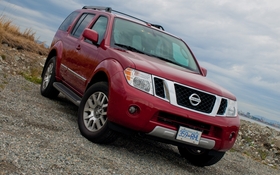2011 Nissan Pathfinder: Historically Accurate
Nissan Pathfinder Road Test
Ask any avid outdoorsman to show you their favorite piece of gear, and chances are good that the device that’s brought before you will be both old, and well used. Having bought and sold numerous rifles and shotguns as my tastes (and my money) came and went, there is but one that I’ll never part with: my dad’s old .22. Hardly an heirloom piece, the old Cooey repeater bears its fair share of war wounds and certainly isn’t the most accurate lead-slinger in the safe, but the mere fact that it was my dad’s old rifle means it’s absolutely indispensable to this soft-hearted sentimentalist. And so it is with the Nissan Pathfinder. One of the most recognizable and longest-running SUV nameplates on the market, the Nissan Pathfinder has taken generations of families into the woods and back out, towed millions of boats to the lake, and brought home lord knows how much game for the freezer. A practical and utilitarian vehicle that put function before form, old Pathfinders are imbued with an almost legendary ability to soldier on, and have earned a spot in many an outdoorsman’s heart as utterly faithful and supremely dependable vehicles.
And much of that same DNA is evident in even this, the newest of Pathfinders. With aggressive styling that borrows heavily from Nissan’s Frontier pickup truck, the big SUV is at once both thoroughly modern, and yet instantly recognizable as a Nissan Pathfinder. Familiar proportions, heavily flared fenders, and those uniquely vertical rear door handles ensure that it’s not mistaken for anything else, whilst tall, unadorned flanks and spartan styling make sure it looks like a product of the 21st century. However, with the inception of the off-road biased Xterra freeing the Pathfinder up for a move upmarket, enthusiasts shouldn’t be surprised to see a few visible concessions to luxury; ranging from the big, expensive-looking wheels, to the lower ride height, to the longer overhangs that lengthen the truck’s footprint by nearly two feet.
Of course, once inside, those concessions to luxury make perfect sense. With a low beltline and a tall greenhouse, the big SUV is quite airy inside whilst the longer wheelbase and greater overall length ensure that each row has more than enough room to remain comfortable. This being the first generation of Pathfinder to benefit from a third row of seating, Nissan has done their homework and devised a folding seat design that allows for a completely flat and flush load floor with the seats folded down, and a deeper, still-commodious trunk area when the smallish rearmost seats are deployed. As with all Nissan vehicles, the interior is constructed from a mix of foam rubber and plastic; both of which are first-rate. Add in the seats, which are the very pictures of superlative comfort, and you have a wonderfully pleasant vehicle to drive that gives great sights lines and is very comfortable. Of particular note is the well-designed and easily manipulated centre console and excellent door panels that offer up a nice flat shelf for your arm to rest on.
And that particular arm rest comes in handy a lot, because you won’t often find yourself wrestling with the steering wheel. Powered by a relatively staid 4.0L V6 (unless you opt for the big V8) and sitting on a lofty suspension system obviously tuned for comfort, cornering is something that’s best accomplished at slower speeds. But, although it may suffer from some of the instability that big, ladder-framed SUVs are infamous for, the Pathfinder more than makes up for it with a huge amount of ride comfort. With near perfect sound deadening and a magic carpet-like ride, the truck feels just as comfortable at 110 as it does at 50. Combine that with its comfortable cabin and huge windows and you’ve got an SUV that just begs to consume kilometers by the hundreds, rather than the dozens. Sadly, I didn’t get a chance to take the big truck off the beaten path, but I’m sure that it handles moderate tasks just fine. Of course, if I were really shopping for something to take me into the wilderness, I’d probably take a longer look at the Xterra, but the Pathfinder’s low range transfer case and completely killable traction control system gives me a lot of faith that it’ll power through most things that people will reasonably subject it to.
And of course, this being a Pathfinder, it’ll do just that for decades to come. Just as I’m sure there’s more than a few new .22s on the market that are destined to be heirlooms, the 2011 Nissan Pathfinder seems to be a vehicle that follows in the footsteps of its forefathers, for better or worse. Slightly less mature and not quite as refined as the latest crop of unibody SUVs it competes with, the Pathfinder is an old school SUV in every way; tough, capable, big, and comfortable… but also thirsty and soft around edges. Does that make it inherently bad? No. Because for every uber-efficient, underpowered, stiffly sprung unibody SUV on the road, there’s a task that’s it’s incapable of. And as long as there’s folks out there willing to wake up at four in the morning to outsmart some fish, or endure hours on a dirt road with both their family and a tent trailer in tow, or shoulder their rifle for a day’s walk through some snowbound woods miles from the nearest service station, there will continue to be a market for the Nissan Pathfinder; that much has been proven over the last 25 years. And I don’t think that’s a bad thing at all.












